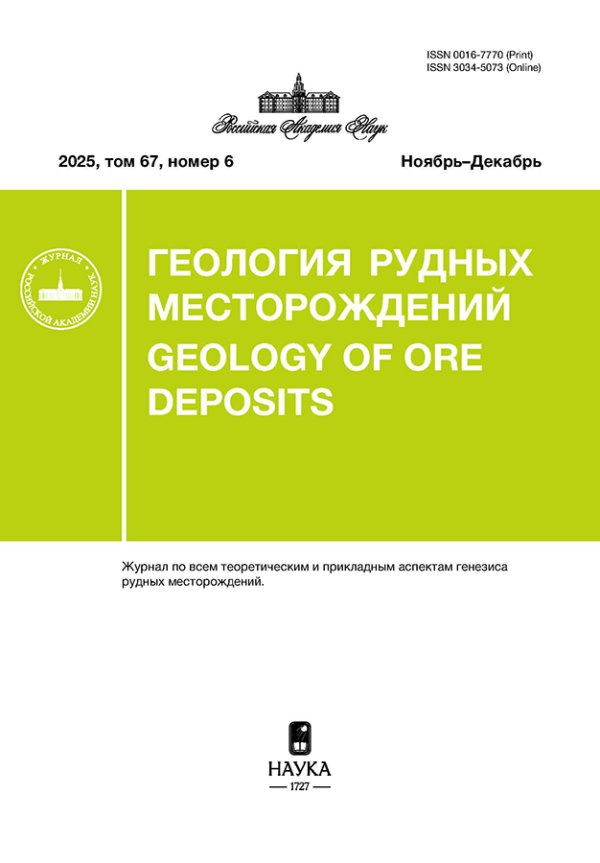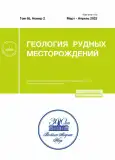The Birkachan Epithermal Au–Ag Deposit in the Kedonsky Middle Paleozoic Volcanic Belt (Russian Northeast)
- Authors: Volkov A.V.1, Savva N.E.2, Prokofiev V.Y.1, Ishkov B.I.3, Murashov K.Y.1, Dolomanova-Topol A.A.1, Sidorova N.V.1
-
Affiliations:
- Institute of Geology of Ore Deposits, Petrography, Mineralogy, and Geochemistry, Russian Academy of Sciences
- Shilo North-Eastern Interdisciplinary Research Institute, Far East Branch, Russian Academy of Sciences
- CJSC Omolon Gold Mining Company
- Issue: Vol 65, No 2 (2023)
- Pages: 111-137
- Section: Articles
- URL: https://journals.rcsi.science/0016-7770/article/view/134672
- DOI: https://doi.org/10.31857/S0016777022060065
- EDN: https://elibrary.ru/GAKUPO
- ID: 134672
Cite item
Full Text
Abstract
The Birkachan deposit in the Middle Paleozoic Kedonsky Volcanic Belt (KVB) is unique in Northeast Russia for its stockwork epithermal Au–Ag ores. The deposit is located in the northeastern part of the Gurnik volcanotectonic depression, in the Kedonsky segment of the KVB. The deposit is localized in the lying side of a large sublatitudinal thrust fault, due to which it was overlain in the Jurassic–Early Cretaceous by allochthon rocks and, therefore, was slightly eroded, as evidenced by the preserved fragments of the argillisite cap. The ore-bearing Gurnik sequence is composed of felsic tuffs and lavas with intercalations of ignimbrites. The main ore-bearing zone of the Birkachan deposit is 4.5 km long and 200–300 m wide consists of several echelon-like vein zones of northeast strike, falling to the southeast at angles of 55°–70°. Most of the ore bodies are linear stockworks. Single, lenticular rich ore bodies represented by mineralized breccias have been found at deep horizons. In the section, the system of ore bodies of the Birkachan deposit forms a fan-shaped structure. The main textures of ores are vein-disseminated, breccia, and rhythmically banded. The ores are enriched in comparison with the upper continental crust in a rather narrow range of elements (Au, Ag, Sb, As, Mo, W, and Li) and are poor in rare-earth elements, among which light lanthanides predominate. The sulfide grade of ores is 0.1–0.5%. The vein minerals in ores are dominated by quartz, sericite, and siderite. Among the ore minerals, pyrite dominates, with fahlore, native gold and chalcopyrite, and minerals of the series acanthite → Se–acantite → naumannite, pearceite, and Se–pearceite being less common. The average fineness value of native gold is 643‰. The parameters of mineral-forming solutions correspond to typical medium-temperature fluids of epithermal low-sulfidized deposits: homogenization temperature of 93–291°С, salt concentration of 0.2–7.0 wt % eq. NaCl, and fluid density of 0.71–0.99 g/cm3. The main indicators of fluid composition are CO2/CH4 = 15.8–23.6, Na/K = 2.3–4.3, and K/Rb = 2007. The prospects for increasing the reserves of Au and Ag are associated with further study and exploration of the flanks and deep horizons of the deposit.
About the authors
A. V. Volkov
Institute of Geology of Ore Deposits, Petrography, Mineralogy, and Geochemistry, Russian Academy of Sciences
Email: tma2105@mail.ru
119071, Moscow, Russia
N. E. Savva
Shilo North-Eastern Interdisciplinary Research Institute, Far East Branch, Russian Academy of Sciences
Email: tma2105@mail.ru
685010, Magadan, Russia
V. Yu. Prokofiev
Institute of Geology of Ore Deposits, Petrography, Mineralogy, and Geochemistry, Russian Academy of Sciences
Email: tma2105@mail.ru
119071, Moscow, Russia
B. I. Ishkov
CJSC Omolon Gold Mining Company
Email: tma2105@mail.ru
685000, Magadan, Russia
K. Yu. Murashov
Institute of Geology of Ore Deposits, Petrography, Mineralogy, and Geochemistry, Russian Academy of Sciences
Email: tma2105@mail.ru
119071, Moscow, Russia
A. A. Dolomanova-Topol
Institute of Geology of Ore Deposits, Petrography, Mineralogy, and Geochemistry, Russian Academy of Sciences
Email: tma2105@mail.ru
119071, Moscow, Russia
N. V. Sidorova
Institute of Geology of Ore Deposits, Petrography, Mineralogy, and Geochemistry, Russian Academy of Sciences
Author for correspondence.
Email: tma2105@mail.ru
119071, Moscow, Russia
References
- Акинин В.В., Глухов А.Н., Ползуненков Г.О., Альшевский А.В., Алексеев Д.И. Возраст эпитермального золото-серебряного оруденения на месторождении Кубака (Омолонский кратонный террейн, Северо-Восток России): геологические и изотопно-геохронологические (U-Pb, 40Ar/39Ar) ограничения // Тихоокеанская геология. 2020. Т. 39. № 1. С. 37–47. https://doi.org/10.30911/0207-4028-2020-39-1-37-47
- Борисенко А.С. Изучение солевого состава газово-жидких включений в минералах методом криометрии // Геология и геофизика. 1977. № 8. С. 16−27.
- Бортников Н.С. Геохимия и происхождение рудообразующих флюидов в гидротермально-магматических системах в тектонически активных зонах // Геология руд. месторождений. 2006. Т. 48. № 1. С. 3–28.
- Винокуров С.Ф., Коваленкер В.А., Сафонов Ю.Г., Керзин А.Л. Лантоноиды в кварцах эпитермальных золоторудных месторождений: распределение и генетическое значение // Геохимия. 1999. № 2. С. 171–180.
- Волков А.В., Савва Н.Е., Сидоров А.А. Металлогения золота и серебра кедонского (D2–3) вулканоплутонического пояса (Северо-Восток России) // ДАН. 2011. Т. 439. № 5. С. 460–484.
- Волков А.В., Ишков Б.И., Савва Н.Е., Сидоров А.А. Роль надвигов в формировании Au–Ag эпитермальных месторождений в палеозойском Кедонском вулканическом поясе (Северо-восток России) // ДАН. 2014. Т. 457. № 6. С. 682–686. https://doi.org/10.7868/S0869565214240219
- Волков А.В., Сидоров А.А., Савва Н.Е., Прокофьев В.Ю., Колова Е.Е., Мурашов К.Ю., Земскова М.И. Особенности эпитермального рудообразования в Кедонском палеозойском вулканоплутоническом поясе Северо-Востока России по данным геохимических исследований Au–Ag оруденения // Вулканология и сейсмология. 2016. № 6. С. 3–21. https://doi.org/10.7868/S0203030616060079
- Волков А.В., Сидоров А.А., Прокофьев В.Ю., Савва Н.Е., Колова Е.Е., Мурашов К.Ю. Геохимические особенности эпитермальных Au–Ag месторождений Охотско-Чукотского вулканоплутонического пояса (Северо-Восток России) // Вулканология и сейсмология. 2018. №. 6. С. 1–20. https://doi.org/10.1134/S0203030618060093
- Волков А.В., Савва Н.Е., Ишков Б.И., Сидоров А.А., Колова Е.Е., Мурашов К.Ю. Палеозойское Au–Ag эпитермальное месторождение Бургали (Северо-восток России) // Геология руд. месторождений. 2021. Т. 63, № 1. С. 40–61. https://doi.org/10.31857/S0016777020060088
- Гагиева А.М. Среднепалеозойский вулканизм Омолонского массива (Северо-Восток Азии): особенности химического состава и проблемы геодинамической интерпретации // Вестник ОНЗ РАН. 2014. Т. 6. С. 1–12. DOI:, 2014https://doi.org/10.2205/2014NZ000122
- Горячев Н.А., Егоров В.Н., Савва Н.Е., Кузнецов В.М., Фомина М.И., Рожков П.Ю. Геология и металлогения фанерозойских комплексов юга Омолонского массива. Владивосток: Дальнаука, 2017.
- Егоров В.Н. Строение, магматизм и металлогения среднего палеозоя юга Омолонского массива // Автореф. дисс. … канд. геол.-мин. наук. Магадан: СВКНИИ ДВО РАН, 2004.
- Егоров В.Н., Шерстобитов П.А. Кедонская вулкано-плутоническая ассоциация юго-восточной части Омолонского массива // Магматизм и метаморфизм Северо-Востока Азии. Материалы IV регионального петрографического совещания по Северо-Востоку России. Магадан: Кн. изд-во, 2000. С. 23–29.
- Егоров В.Н., Ермоленко В.Г., Грищенко Ш.Г. Государственная геологическая карта. Масштаб 1 : 200 000 (новая серия). Лист P-57-IV. Объяснительная записка. М.: МФ ВСЕГЕИ, 2013.
- Жариков В.А., Горбачев Н.С., Латфутт П. и др. Распределение редкоземельных элементов и иттрия между флюидом и базальтовым расплавом при давлениях 1–12 кбар (по экспериментальным данным) // ДАН. 1999. Т. 366. № 2. С. 239–241.
- Котляр И.Н., Жуланова И.Л., Русакова Т.Б., Гагиева А.М. Изотопные системы магматических и метаморфических комплексов Северо-Востока России. Магадан: СВКНИИ ДВО РАН, 2001.
- Кравцова Р.Г. Геохимия и условия формирования золотосеребряных рудообразующих систем Северного Приохотья. Новосибирск: Академическое издательство “ГЕО”, 2010.
- Кряжев С.Г., Прокофьев В.Ю., Васюта Ю.В. Использование метода ICP MS при анализе состава рудообразующих флюидов // Вестник МГУ. Серия 4 Геология. 2006. № 4. С. 30–36.
- Наталенко М.В., Стружков С.Ф., Рыжов А.Б., Вакин М.Е., Ишков Б.И., Гиллес Б., Карчавец В.П. Устинов В.И., Шергина Ю.П. Геологическое строение и минералогия руд месторождения Биркачан, Магаданская область // Руды и металлы. 2002. № 6. С. 37–52.
- Наталенко М.В. Гидротермально-метасоматические изменения вмещающих пород Биркачанского золото-серебряного месторождения, Магаданская область // Руды и металлы, 2003. № 3. С.35–42.
- Минеев Д.А. Лантаноиды в рудах редкоземельных и комплексных месторождений. М.: Наука, 1974.
- Реддер Э. Флюидные включения в минералах. М.: Мир, 1987. Т. 1, 2.
- Савва Н.Е. О возможном источнике селена в вулканогенных месторождениях // Наука Северо-Востока России – начало века: Матер. Всеросс. научн. конф., посвящ. памяти академика К.В. Симакова и в честь его 70-летия (Магадан, 26–28 апреля 2005 г.). Магадан: СВНЦ ДВО РАН, 2005. С. 208–210.
- Савва Н.Е. Минералогия серебра Северо-Востока России. М.: Изд-во “Триумф”, 2018.
- Сидоров А.А., Волков А.В. О металлогении кратонных террейнов Северо-Востока России // Геология и геофизика. 2006. № 12. С. 1242–1257.
- Сидоров А.А., Волков А.В., Савва Н.Е. Вулканизм и эпитермальные месторождения // Вулканология и сейсмология. 2015. № 6. С. 1–10. https://doi.org/10.7868/S0203030615060085
- Сидоров А.А., Савва Н.Е., Ишков Б.И., Волков А.В., Степанов В.А., Шишакова Л.Н. Возраст эпитермального золото-серебряного оруденения на месторождении Кубака (Омолонский кратонный террейн, Северо-Восток России): геологические и изотопно-геохронологические (U-Pb, 40Ar/39Ar) ограничения – дискуссия // Тихоокеанская геология 2021. Т. 40. № 2. С.90–97. https://doi.org/10.30911/0207-4028-2021-40-2-90-97
- Степанов В.А. О геологическом и изотопном возрасте золоторудных месторождений на примере золото-серебряного месторождения Кубака (Северо-Восток России) // Вестник СВНЦ. 2021. №1. С. 3–13. https://doi.org/10.34078/1814-0998-2021-1-3-12
- Степанов В.А., Шишакова Л.Н. Кубакинское золото-серебряное месторождение. Владивосток: Дальнаука, 1994.
- Тейлор С.Р., Мак-Леннан С.М. Континентальная кора: ее состав и эволюция. М.: Мир, 1988.
- Шпикерман В.И. Домеловая минерагения Cеверо-Востока Азии. Магадан: СВКНИИ ДВО РАН, 1998.
- Bindi L., Pingitore N.E. On the symmetry and crystal structure of aguilarite, Ag4SeS. Mineralogical Magazine: 2013, 77, 21-31. https://doi.org/10.1180/minmag.2013.077.1.03
- Bindi L., Evain M., Spry P.G, Menchetti S. The pearceite-polybasite group of minerals: Crystal chemistry and new nomenclature rules. Amer. Mineral. 2007. 92. P. 918–925.
- Bodnar R.J., Vityk M.O. Interpretation of microterhrmometric data for H2O−NaCl fluid inclusions // Fluid inclusions in minerals: methods and applications. Pontignano: Siena, 1994. P. 117−130.
- Brown P. FLINCOR: a computer program for the reduction and investigation of fluid inclusion data // Amer. Mineral. 1989. V. 74. P. 1390–1393.
- Izava E., Urashima Y., Ibaraki K., Suzuki R., Yokoyama T., Kawasaki K., Koga A., Taguchi S. The Hishikari gold deposits: high-grade epithermal veins in Quaternary volcanic of southern Kyushu, Japan//Epithermal gold mineralization of the Circum-Pacific. Elsevier, 1990. P. 1–56.
- Izawa E., Kurihara M., Itaya T. Ar ages and the initial Ar isotopic ratio of adularia-quartz veins from the Hishikari gold deposit, Japan // Resource Geology. 1993. Special Issue 14. P. 63–69.
- Jones B., Manning D.A.C. Comparison of geochemical indices used for the interpretation of palaeoredox conditions in ancient mudstones // Chem. Geol. 1994. V. 111. P. 111–129.
- Henry C.D., Elson H.B., McIntosh W.C., Heizler M.T., Castor S.B. Brief duration of hydrothermal activity at Round Mountain, Nevada, determined from 40Ar/39Ar geochronology // Economic Geology. 1997. V. 92. P. 807–826.
- Lindblom S. Organic matter and gold deposition in disseminated gold deposits in Nevada // Source, Transport and Deposition of Metals. Rotterdam: Balkema, 1991. P. 553–556.
- McDonough W. F., Sun S. S. The Composition of the Earth // Chem. Geol. 1995. V. 120. P. 223–253.
- Nash J.T. Fluid inclusion studies of some gold deposits in Nevada. Denver: U.S. Geol. Survey, 1972. Prof. Paper. 800.
- Sander M.V, Einaudi M.T. The Round Mountain gold-silver mine, Nye County, Nevada // Bulk Mineable Precious Metal Deposits of the Western United States / Johnson J L (Ed.) – Guidebook for Field Trips Geol. Soc. Nevada, 1987. P. 130–135.
- Sanematsu K., Watanabe K., Duncan R., Izawa E. Duration of mineralization and timing of vein at the Hishikari epithermal gold deposit, southern Kyushu, Japan, determined by 40Ar/39Ar dating // Proceedings 25”NZ Geothermal Workshop, 2003. P. 45–48.
- Sekine R., Izawa E., Watanabe K. Timing of fracture formation of mineralization at the Hishikari deposit, southern Kyushu, Japan // Resource Geology. 2002. V. 52. P. 395–404.
- Simmons F. A., White N. C., John D. A. Geological Characteristics of Epithermal Precious and Base Metal Deposits // Economic Geology 100th Anniversary Volume. 2005. Society of Economic Geologists, Inc. P. 485–522.
Supplementary files























